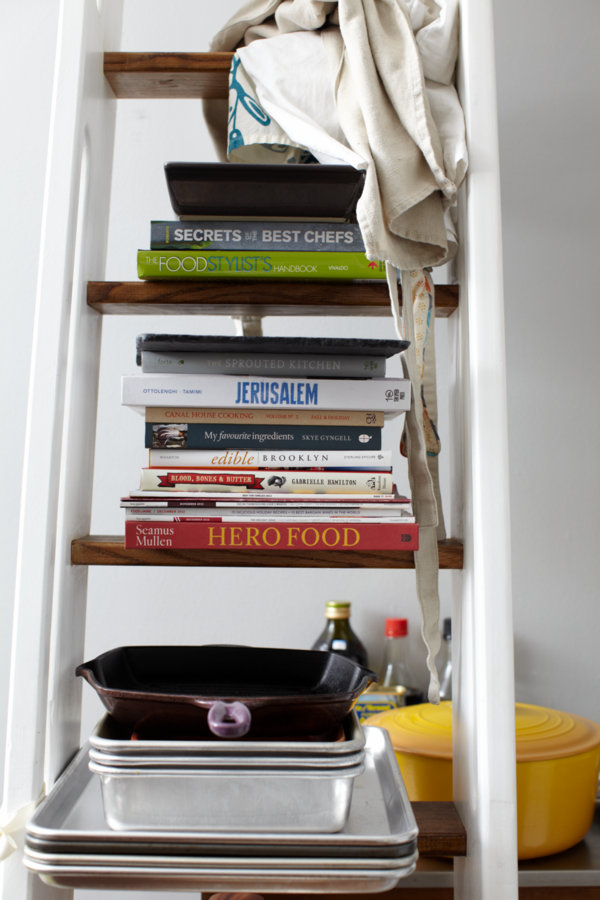
So for this month’s sleep experiments, I wanted to find ways to navigate my waking life that would set me up for bedtime success, instead of dooming those late night hours into becoming the waste of time I’d always feared.
My vice detox and exercise experiments had a positive impact on my ability to fall asleep, but despite my body’s craving, I still hadn’t figured out any consistent ways to get my mind on board with the idea of an earlier bedtime.
Scheduling enough time for eight hours in bed is difficult enough. And unfortunately, I learned the hard way earlier this year that making sleep a priority is only half the battle. If you have on-going sleep problems, it takes a slightly more complex strategy to kick your circadian rhythm back into gear.
I have a lot to report, so I’ll get on with it. Read on below for how I went about trying to get seven to eight hours of sleep every night this month, and all the things that got in the way of those best laid plans!
Xo
Phoebe

Earlier in the spring, when I was down at a writer’s colony in Tennessee, I decided to get a head start on my sleep experiments by doing something crazy: for two weeks, I didn’t set an alarm.
This clearly wouldn’t be feasible for anyone tethered to The Man’s early bird schedule. But even as a freelancer, I have to admit that the idea sounded impressive, but crazy.
My alarm has always been an important safe guard against my autoimmune disease literally taking over my life. Even on lazy weekends, I like having a precautionary peep scheduled, so that I know exactly how much money I’ll be laundering back into the sleep piggybank.
Going alarm free in the counter-reality of a cabin in the woods in some ways might seem like a cop out. But for a control freak like myself, it was a safe way to check-in with the power of circadian rhythm, and see whether in a quiet, dark, Charlie-free sleep utopia, mine still existed.
Letting my body be my sleep guide worked surprisingly well at first. Exhausted from travel, I passed out at 11pm and woke up with the light at 7am. But on the third night, the cynic in my subconscious emerged, and royally messed with my head.
A particularly vivid dream about being sold into sex slavery, starring the cast of Winter’s Bone, left me wide-awake in a cold sweat for hours. I fell back asleep just before sunrise, and without an alarm, my body didn’t stir again until lunchtime. When my eyes met the clock, my whole body seized up in a productivity panic.
At the end of the two weeks, I didn’t feel like listening to my body in this way got me into a better pattern. Instead, I found myself back in the vicious cycle of insomnia. The result was a lot of time spent in bed on my retreat, without the rest and relaxation to show for it.
So where did I go wrong?
It turns out that routine is the most important tactic for building better bedtime habits. You can train yourself onto any sleep cycle, so long as your body knows what’s coming and can adapt. I had missed this by diving into my new sleep journey blind, without enough research on what would work best for my specific set of problems.
This month, I ended up delving into a 5-week program for fighting insomnia. Cognitive Behavioral Therapy (CBT) has proven to be far more effective than sleeping pills at getting your body onto a better sleep schedule, and as part of my month of building better bedroom habits, I definitely wanted to retire my Ambien prescription for good.
To give your body the routine it craves, the first rule of my CBT manual was to stick to a firm wakeup time. The same hour should apply to weekend mornings as well, regardless of how late your last Michael Jackson Karaoke solo was performed the night before.
I tried to keep my alarm set for 7:30am this month, and to limit my snoozing to just 30 minutes. I definitely wasn’t great at sticking with this plan on weekends. But I tried not to sleep in more than an hour so that I wouldn’t be wide awake on Sunday night.
Even though I vowed to keep an early bedtime, I was relieved to learn that this was less important. In fact, going to bed too early can actually make insomnia worse. For people who have trouble falling asleep, the longer you can go between rising and going back to bed, the more likely you’ll be to pass out.
This was incredibly liberating, especially for my relationship. Charlie is much more of a night owl than I am. And because of his busy work schedule, usually that last hour of the day is something to savor, even if it just means a few extra minutes of pillow talk before turning out the lights.
I used to sometimes get annoyed when he kept me up past my bedtime. But knowing that my sleep might not suffer as a result allowed me to relax and enjoy his company, instead of being paranoid about getting to bed by a certain hour. I found that being more tired did help me fall asleep more easily on some nights. But it really depended on how we had spent our time leading up to lights out, which was another area I tried to work on this month.

As the second part of my September experiment, I tried to improve my “sleep hygiene,” which means so much more than just what someone violates when they eat a flakey breakfast pastry in your bed.
These are rituals that can make or break your ability to get a sound night’s sleep. And one of the ones I paid particularly close attention to this month was blue light.
Our circadian rhythm is irrevocably programmed to the rising and setting of the sun, and unfortunately, the blue light emitted by it during daylight hours is now also mimicked by your television set, computer, tablet, phone, and for some of us, the LED tequila worm outside your window.
Since our body is one big web of checks and balances meant to interact with cues from the outside world, the presence of apparent sunlight as you check emails in bed cues your body that sleep is a long ways away. And it does this by suppressing the release of melatonin. Here’s a great article that explains the role of this hormone in setting your internal clock.
To combat blue light, I downloaded the app F.lux onto my computer, which was a huge help. But since I couldn’t find a good one for my iphone, I ended up purchasing these glasses, which look like something a Muppet would wear in the the Tour de France.
I wish I could tell you that I wore them every night. But now that Charlie and I live together, I worried about the amount of revealing lingerie I would need to purchase to offset this fashion choice in the bedroom. So I mostly took my chances with the blue light on my phone and tried not to look at it too much once I went upstairs to my bedroom. Turning it to airplane mode the hour before bed was a great safeguard against mindless pre-sleep browsing.
Overall though, for me, falling sleep is the biggest problem when my mind is running in circles. I can be dead tired, and still my worries will wind me up for hours of tossing and turning. I felt like it was less the blue light that kept me up than the added stimulus of whatever I was looking at. You want to avoid anything that’s going to agitate you before bed, be it an annoying email from your boss or a plot twist that you’ll be pulling apart for hours. Because of this, I found that reading of any sort, even if it’s done on a device, helped me get in a better headspace for sleep.
You may have heard about the children’s book The Rabbit Who Wanted to Fall Asleep at some point this summer, when it topped the Amazon charts. Written by Carl-Johan Forssén Ehrlin, a Swedish psychologist, the self-published book uses a carefully researched language pattern that promises to put any child to sleep. It even comes with a warning label in the introduction to not read the book aloud around anyone operating a moving vehicle.
I imagined it would look like a magic eye picture book and read with the excitement of something narrated by Ben Stein, using the best tactics of sleep manipulation: trance and boredom.
After reading a few positive accounts of parents who ended up contributing to the drool puddle on their child’s pillow, I decided to order the book and see if the science worked on big kids too. So with my iPad in hand, Charlie and I embarked on one of the more absurd, and least erotic experiments of my wellness project: adult bedtime stories.
The book turned out to be a typical, if intentionally low-action, tale of a young insomniac bunny and his mother’s quest to solve his sleep problems. As she takes Roger (meant to be pronounced, R-ahhh-gaaahr with a double yawn) on a journey to meet his Uncle, and encounters new friends like the Sleepy Snail and Heavy-Eyed Owl on the way, the reader is instructed to emphasize certain words, and in places insert the name of the child, so they may find solidarity with Roger and therefore, be just as susceptible to his inevitable fate of dreamdom.
Perhaps being slightly annoyed at the task at hand, the first time Charlie read it out loud, he didn’t give me his best fairy-tale voice as instructed. And as a result, the emphasized words, which usually included the instruction “fall asleep now,” turned The Rabbit Who Wanted to Fall Asleep into a very bossy book.
“Do you think this is what Bill Cosby read to his victims?” Charlie interjected at one point, during a passage about Uncle Yawn’s sleep dust.
But even with jokes and other interruptions, and the creepiness of having your lover read you a bedtime story in which he calls you Phoebe rabbit, the book still managed to achieve its goal of lulling us to sleep. The drowsiness didn’t pounce on us with the onset of an Ambien. But we both hit the pillow and drifted off faster than usual.
I seemed to find a hypnosis-induced calm that hovered in the space between the story and my daytime anxiety. It was a meditation of sorts, without the energy resurgence that comes from putting your mind on hold during the day.
I don’t think the rabbit book will become an every day addition to our shared bedtime routine. But it was a nice reminder about the power of reading before bed, even when there’s no fairy tale voice involved.
My sleep hygiene was only as good as the person’s sleeping next to me.
Your sleep problems don’t happen in a vacuum. The habits of people you share a bed with matter!
Most scientific sleep studies only look at an individual’s behavior in the context of a lab environment. And yet, the cultural norm is a shared bed. Because of this, it can be hard to know what factors disrupt sleep most, the blue light from an iPad or your snoring boyfriend right next to you.
I read a fascinating book called Sleeping Better Together that tackled some of these issues, and also gave me some much needed insight into how men and women differ in the bedroom. FYI ladies, we are more than 1.5 times more likely to develop sleep disorders. And unsurprisingly, men are the majority of the snorers.
Because of his part in my sleep deprivation, Charlie was kind enough to buy me a fancy sleep monitoring device as a gift last year. It’s been very interesting to see my results on nights that we’re together compared to nights we are apart. I won’t go into the specifics, but the numbers aren’t pretty.
I do think though that sleeping side by side gives me a different type of mental and physical comfort than just the minutes logged in my REM or deep sleep cycle. The authors of the book noted that this was not an unusual feeling. “Women are more likely to say that their sleep time, whether or not it is interrupted, is more comfortable and emotionally satisfying when spent next to a partner,” even though we are the ones who suffer most from a shared bed.
I could go on about some of the joys and miseries of joint sleep habits. But I’ll have to save some of that material for MY book.
Have you ever struggled with sleep? Do you have any rules you set for yourself to balance work/social life/SO QT with the needs of your body’s circadian rhythm? Any apps, devices or products that have helped you sleep soundly? I would love to know in the comments section!
The Wellness Project is now a book! It’s part memoir, part health primer, with 20 inflammation fighting recipes for clearer skin, better digestion, and a thriving thyroid. (Because who doesn’t wake up in the morning wanting a thriving thyroid?!). You can read more and preorder here. To read up on past experiments and get more tips from the trenches, click here.

I have really enjoyed my “dumb” kindle (the kind with no backlighting at all) for reading in bed. It’s a good way to end the day.
I’d also recommend light alarm clocks. I lucked out and found one that you can plug into whatever lamp you’d like, and that made for a much more pleasant winter-time wake up.
Love the dumb kindle!!
I debated getting one of these! Which brand do you like?
I’d be interested to know the effects of a sleep mask on both sleeping habits as well as skin… Did you come across any of that in your research?
Anything that eliminates light is a good thing! I personally can’t get used it – feels funny on my head and makes my hair feel claustrophobic 🙂 No idea what it does for skin, but I don’t think it could be a bad thing. Maybe wash it now and then so it doesn’t get dirty/dusty? xo
There are lots of tasks you can give your mind when your head hits the pillow to help lure it away from the anxiety-ruts it circles in. Like focusing on one part of your body after another – eyes, chin, neck, fingertips for example – and telling it to sleep. Usually I don’t get to the end of the list of body parts, I fall asleep instead. One actress I know recites a Shakespeare sonnet in her head every night but she never gets to the last line…
I love the idea of the sonnet!! any idea which one she used? The body part exercise is popular. Usually it’s done as part of Progressive Muscle Relaxation, where you tense each area and then relax with your breath. But I like the idea of talking to them too.